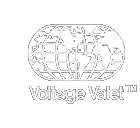Information Center
What's the difference between a transformer and a solid state converter? The important difference is how the device converts voltage.
The household electricity our North American appliances use is delivered at 120VAC (volts alternating current) 60 Hz. (60 cycles/second). When the electric current flows it rises from 0 volts to 120 volts back to 0 volts and then it falls to negative 120 volts and rises back to 0 volts. This rise and fall completes one cycle (1 Hz.) and is called a "sine wave." To convert 240VAC to 120VAC, for example, a transformer reduces the height of the 240 volt sine wave in half creating a 120 volt sine wave that can be safely used by all types of 120 VAC appliances, a solid state converter however chops the sine wave at it's positive and negative 240 volt peak reducing the power in half but creating a chopped waveform that can ONLY be used by NON ELECTRONIC heating appliances.
Cycles: 50 Hz vs. 60 Hz
North American 120 volt electricity is generated at 60 Hz. Alternating Current (AC). Most foreign 220–240 volt electricity is generated at 50 Hz. Alternating Current (AC). This difference in cycles may cause the motor in your 60 Hz. North American appliance to operate slightly slower when used on 50 Hz. foreign electricity.
As a rule of thumb, the appliances that are most affected by cycle differences are those with motors such as turntables, clocks, kitchen appliances, medical equipment and power tools. They will run faster or slower than they should depending upon the cycle difference and may be damaged in the long run as a result. As with any rule of thumb, however, there are many exceptions. The only way to be sure is to consult the appliance's technical documentation or contact the manufacturer.
Most modern electronic equipment, including battery chargers, computers, printers, stereos, MP3 and CD players, VCR/DVD players, etc., will not be affected by the difference in cycles.
IMPORTANT NOTE: Transformers and solid state converters do not convert cycles.
Polarized Plugs
In North America many ungrounded appliances are required to have plugs with one blade wider than the other. This type of plug is called a “polarized plug.” All Voltage Valet converters, adaptor plugs, and heavy duty transformers will accept polarized plugs.
IMPORTANT NOTE: You may find some countries (parts of Central America, Japan, Mexico, etc.) that use the North American style plug without polarized outlets. The Voltage Valet “A” adaptor plug will allow your polarized appliance to operate in those locations.
Recessed European Electrical Outlets
Many countries in Europe use electrical outlets that are recessed into the wall. Voltage Valet converters, models V5B, V16B, VCCB, VCAB and VCSB, will not fit these recessed outlets without our model “B” adaptor plug. See section Electricity Guide for a list of countries using recessed outlets 2, 3, 4 & 6.
European Shaver Sockets
CAUTION: The 120–240 volt AC electrical "Shaver" outlets found in many foreign bathrooms are only for use with low wattage appliances rated at 5 to 10 watts maximum: e.g., electric shavers and electric toothbrushes. Using your hair dryer or other high-wattage appliance on this outlet, even with a voltage converter, will blow the main fuse or circuit breaker and may damage your converter and appliance. Use a regular outlet instead, sometimes not available in bathrooms.
Surge Protectors, UPS Systems
WARNING: Do not use North American 120 volt surge protectors or UPS Systems (Uninterruptable Power Supplies) with overseas 220–240 volt AC electrical systems, even with a step down voltage transformer. North American electrical systems are not wired the same way as overseas electrical systems and damage could result when using these devices.
Japan Voltage
Japan uses 100 VAC and special Japan/North America voltage transformers may be required when traveling to and from Japan.
A Few Reminders
Voltage converters and North American appliances will not operate on Direct Current voltage (volts DC).
In a foreign country or on a cruise ship, always check the type of electrical current (AC or DC) and voltage (100, 120, 220, 230 or 240 volts AC) before using your converter or dual voltage appliance.
Read all instructions and always check the appliance you plan to use with a converter for voltage requirement, wattage rating, and type (motorized, electronic, heating, etc.). Also, be sure that the appliance is operating properly before you leave.
|



